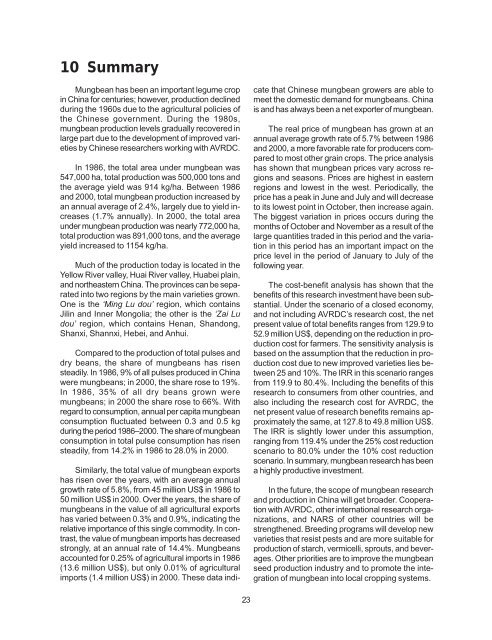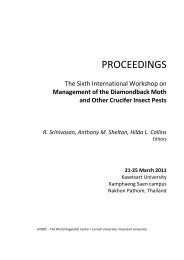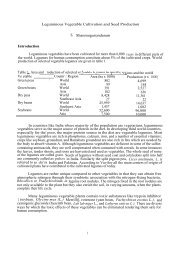The Impact of Mungbean Research in China
The Impact of Mungbean Research in China
The Impact of Mungbean Research in China
You also want an ePaper? Increase the reach of your titles
YUMPU automatically turns print PDFs into web optimized ePapers that Google loves.
10 Summary<strong>Mungbean</strong> has been an important legume crop<strong>in</strong> Ch<strong>in</strong>a for centuries; however, production decl<strong>in</strong>eddur<strong>in</strong>g the 1960s due to the agricultural policies <strong>of</strong>the Ch<strong>in</strong>ese government. Dur<strong>in</strong>g the 1980s,mungbean production levels gradually recovered <strong>in</strong>large part due to the development <strong>of</strong> improved varietiesby Ch<strong>in</strong>ese researchers work<strong>in</strong>g with AVRDC.In 1986, the total area under mungbean was547,000 ha, total production was 500,000 tons andthe average yield was 914 kg/ha. Between 1986and 2000, total mungbean production <strong>in</strong>creased byan annual average <strong>of</strong> 2.4%, largely due to yield <strong>in</strong>creases(1.7% annually). In 2000, the total areaunder mungbean production was nearly 772,000 ha,total production was 891,000 tons, and the averageyield <strong>in</strong>creased to 1154 kg/ha.Much <strong>of</strong> the production today is located <strong>in</strong> theYellow River valley, Huai River valley, Huabei pla<strong>in</strong>,and northeastern Ch<strong>in</strong>a. <strong>The</strong> prov<strong>in</strong>ces can be separated<strong>in</strong>to two regions by the ma<strong>in</strong> varieties grown.One is the ‘M<strong>in</strong>g Lu dou’ region, which conta<strong>in</strong>sJil<strong>in</strong> and Inner Mongolia; the other is the ‘Zai Ludou’ region, which conta<strong>in</strong>s Henan, Shandong,Shanxi, Shannxi, Hebei, and Anhui.Compared to the production <strong>of</strong> total pulses anddry beans, the share <strong>of</strong> mungbeans has risensteadily. In 1986, 9% <strong>of</strong> all pulses produced <strong>in</strong> Ch<strong>in</strong>awere mungbeans; <strong>in</strong> 2000, the share rose to 19%.In 1986, 35% <strong>of</strong> all dry beans grown weremungbeans; <strong>in</strong> 2000 the share rose to 66%. Withregard to consumption, annual per capita mungbeanconsumption fluctuated between 0.3 and 0.5 kgdur<strong>in</strong>g the period 1986–2000. <strong>The</strong> share <strong>of</strong> mungbeanconsumption <strong>in</strong> total pulse consumption has risensteadily, from 14.2% <strong>in</strong> 1986 to 28.0% <strong>in</strong> 2000.Similarly, the total value <strong>of</strong> mungbean exportshas risen over the years, with an average annualgrowth rate <strong>of</strong> 5.8%, from 45 million US$ <strong>in</strong> 1986 to50 million US$ <strong>in</strong> 2000. Over the years, the share <strong>of</strong>mungbeans <strong>in</strong> the value <strong>of</strong> all agricultural exportshas varied between 0.3% and 0.9%, <strong>in</strong>dicat<strong>in</strong>g therelative importance <strong>of</strong> this s<strong>in</strong>gle commodity. In contrast,the value <strong>of</strong> mungbean imports has decreasedstrongly, at an annual rate <strong>of</strong> 14.4%. <strong>Mungbean</strong>saccounted for 0.25% <strong>of</strong> agricultural imports <strong>in</strong> 1986(13.6 million US$), but only 0.01% <strong>of</strong> agriculturalimports (1.4 million US$) <strong>in</strong> 2000. <strong>The</strong>se data <strong>in</strong>di-cate that Ch<strong>in</strong>ese mungbean growers are able tomeet the domestic demand for mungbeans. Ch<strong>in</strong>ais and has always been a net exporter <strong>of</strong> mungbean.<strong>The</strong> real price <strong>of</strong> mungbean has grown at anannual average growth rate <strong>of</strong> 5.7% between 1986and 2000, a more favorable rate for producers comparedto most other gra<strong>in</strong> crops. <strong>The</strong> price analysishas shown that mungbean prices vary across regionsand seasons. Prices are highest <strong>in</strong> easternregions and lowest <strong>in</strong> the west. Periodically, theprice has a peak <strong>in</strong> June and July and will decreaseto its lowest po<strong>in</strong>t <strong>in</strong> October, then <strong>in</strong>crease aga<strong>in</strong>.<strong>The</strong> biggest variation <strong>in</strong> prices occurs dur<strong>in</strong>g themonths <strong>of</strong> October and November as a result <strong>of</strong> thelarge quantities traded <strong>in</strong> this period and the variation<strong>in</strong> this period has an important impact on theprice level <strong>in</strong> the period <strong>of</strong> January to July <strong>of</strong> thefollow<strong>in</strong>g year.<strong>The</strong> cost-benefit analysis has shown that thebenefits <strong>of</strong> this research <strong>in</strong>vestment have been substantial.Under the scenario <strong>of</strong> a closed economy,and not <strong>in</strong>clud<strong>in</strong>g AVRDC’s research cost, the netpresent value <strong>of</strong> total benefits ranges from 129.9 to52.9 million US$, depend<strong>in</strong>g on the reduction <strong>in</strong> productioncost for farmers. <strong>The</strong> sensitivity analysis isbased on the assumption that the reduction <strong>in</strong> productioncost due to new improved varieties lies between25 and 10%. <strong>The</strong> IRR <strong>in</strong> this scenario rangesfrom 119.9 to 80.4%. Includ<strong>in</strong>g the benefits <strong>of</strong> thisresearch to consumers from other countries, andalso <strong>in</strong>clud<strong>in</strong>g the research cost for AVRDC, thenet present value <strong>of</strong> research benefits rema<strong>in</strong>s approximatelythe same, at 127.8 to 49.8 million US$.<strong>The</strong> IRR is slightly lower under this assumption,rang<strong>in</strong>g from 119.4% under the 25% cost reductionscenario to 80.0% under the 10% cost reductionscenario. In summary, mungbean research has beena highly productive <strong>in</strong>vestment.In the future, the scope <strong>of</strong> mungbean researchand production <strong>in</strong> Ch<strong>in</strong>a will get broader. Cooperationwith AVRDC, other <strong>in</strong>ternational research organizations,and NARS <strong>of</strong> other countries will bestrengthened. Breed<strong>in</strong>g programs will develop newvarieties that resist pests and are more suitable forproduction <strong>of</strong> starch, vermicelli, sprouts, and beverages.Other priorities are to improve the mungbeanseed production <strong>in</strong>dustry and to promote the <strong>in</strong>tegration<strong>of</strong> mungbean <strong>in</strong>to local cropp<strong>in</strong>g systems.23
















